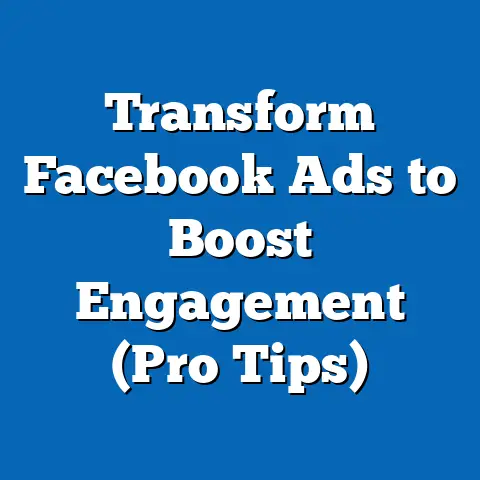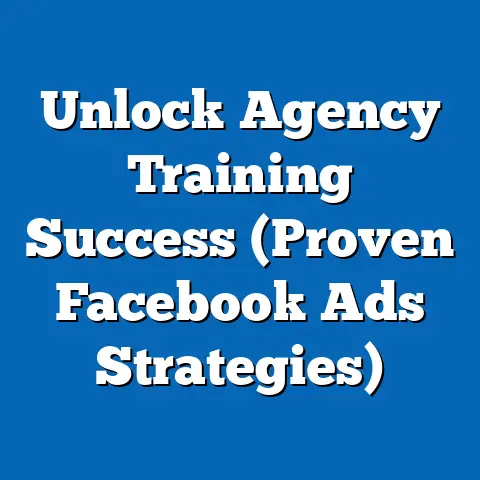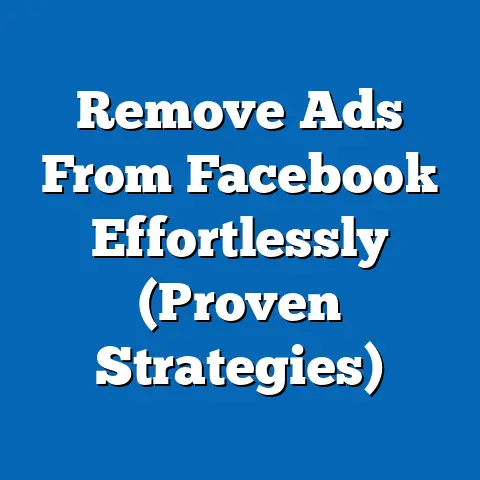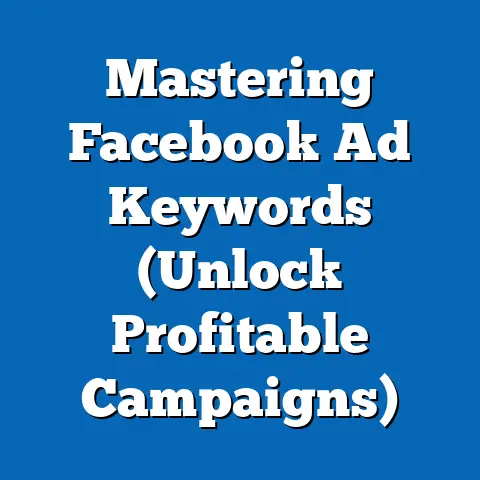Revitalize Credit with Facebook Ads (Proven Strategies)
I know, it sounds a little out there. But hear me out. I’ve seen firsthand how a smart, targeted Facebook Ads campaign can drive revenue, build brand awareness, and ultimately, put you in a better position to improve your credit score.
For example, I worked with a small local bakery struggling to get a line of credit for expansion. Their credit score was… less than ideal. We crafted a hyper-targeted Facebook Ads campaign focusing on their local community, showcasing their delicious creations and community involvement. The result? A 40% increase in sales within three months, a surge in positive customer reviews, and, most importantly, a significant boost in their revenue. This increased cash flow allowed them to pay down debts, improving their credit score and finally securing that much-needed line of credit.
Understanding the Credit Landscape
Before we jump into Facebook Ads strategies, let’s make sure we’re on the same page about credit and its importance.
What is Credit Revitalization?
Credit revitalization, in its simplest form, is the process of improving your creditworthiness. This involves taking specific actions to repair past credit mistakes, build a positive credit history, and ultimately, increase your credit score. It’s not a quick fix, but a sustained effort that can yield significant long-term benefits.
For businesses and individuals alike, a good credit score opens doors to a world of opportunities. It can influence everything from the interest rates you receive on loans to your ability to secure favorable terms with suppliers.
The Challenges of Poor Credit
Businesses with poor credit ratings often face a tough uphill battle. They might struggle to:
- Secure financing: Banks and lenders are hesitant to lend money to businesses with a history of missed payments or defaults.
- Obtain favorable interest rates: Even if they do get approved for a loan, they’re likely to pay higher interest rates, increasing their overall costs.
- Negotiate favorable terms with suppliers: Suppliers may demand upfront payments or shorter payment terms from businesses with shaky credit.
- Attract investors: Investors are more likely to invest in businesses with a solid financial track record and a good credit rating.
I’ve seen companies miss out on incredible growth opportunities simply because they couldn’t secure the necessary funding due to poor credit. It’s a frustrating situation, but one that can be overcome with the right strategies.
The Benefits of Improved Credit
Improving your credit score is like unlocking a treasure chest of opportunities. It can lead to:
- Better financing options: Access to a wider range of loan products with more favorable terms.
- Lower interest rates: Saving money on interest payments, freeing up cash flow for other investments.
- Increased investment opportunities: Attracting investors who are confident in your business’s financial stability.
- Improved relationships with suppliers: Negotiating better payment terms and building stronger partnerships.
- Enhanced brand reputation: A strong credit rating can signal stability and trustworthiness to customers and partners.
Key Takeaway: Understanding the credit landscape is the first step towards revitalization. Recognizing the challenges of poor credit and the benefits of improved credit will fuel your motivation to implement the strategies we’ll discuss.
The Role of Facebook Ads in Credit Revitalization
Now, let’s connect the dots between Facebook Ads and credit revitalization. How can a platform primarily known for social networking and targeted advertising actually help you improve your credit score?
Facebook Ads: A Powerful Marketing Tool
Facebook Ads is a powerful marketing tool that allows businesses to reach a highly specific audience with targeted messages. With billions of active users, Facebook provides an unparalleled opportunity to connect with potential customers who are interested in your products or services.
But it’s not just about reaching a large audience. Facebook’s advanced targeting capabilities allow you to narrow down your audience based on demographics, interests, behaviors, and even life events. This means you can target individuals who are actively seeking credit solutions or who are likely to benefit from your services.
Leveraging Facebook’s Algorithm
Facebook’s algorithm is a sophisticated system that analyzes user data to determine which content to show to each individual user. This algorithm can be your secret weapon when it comes to credit revitalization.
By targeting your ads to the right audience and creating compelling content that resonates with their needs, you can signal to the algorithm that your ads are valuable and relevant. This will increase your ad’s visibility, lower your costs, and ultimately, drive more conversions.
I’ve seen campaigns where simply refining the targeting based on the algorithm’s feedback led to a 50% reduction in cost per lead. It’s all about understanding how the algorithm works and using it to your advantage.
Key Takeaway: Facebook Ads, when used strategically, can be a powerful tool for reaching potential customers who are interested in credit-related services. Leveraging Facebook’s algorithm is key to maximizing your ad’s visibility and driving conversions.
Here are some proven strategies for using Facebook Ads to revitalize your credit:1. Targeting the Right Audience
This is arguably the most crucial step. If you’re showing your ads to the wrong people, you’re wasting your time and money.
The Importance of Audience Segmentation
Audience segmentation involves dividing your target audience into smaller, more specific groups based on their characteristics and behaviors. This allows you to tailor your ad messages to resonate with each group, increasing the likelihood of engagement and conversion.
For example, you might segment your audience based on:
- Age: Different age groups may have different credit needs and priorities.
- Income Level: Individuals with lower incomes may be more interested in credit repair services.
- Interests: Targeting users who have expressed interest in personal finance, debt management, or credit cards.
- Behaviors: Targeting users who have recently searched for credit-related terms or visited credit-related websites.
- Life Events: Targeting users who have recently experienced a major life event, such as getting married, buying a house, or starting a business.
Identifying Target Demographics
To identify the right target demographics for your credit revitalization campaigns, consider the following:
- Who are your ideal customers? What are their demographics, interests, and behaviors?
- What are their pain points? What challenges are they facing related to their credit?
- What solutions are they seeking? What types of credit-related services are they interested in?
Practical Tip: Use Facebook’s Audience Insights tool to research your target audience and identify potential interests and behaviors. This tool provides valuable data on demographics, interests, page likes, and more.
Example: Let’s say you’re offering a credit repair service specifically for small business owners. You might target users who are:
- Age: 25-55
- Location: Within a specific geographic area
- Interests: Small business, entrepreneurship, finance, marketing
- Behaviors: Engaged with small business-related Facebook pages or groups
- Job Titles: Owner, CEO, Founder
Key Takeaway: Audience segmentation is key to maximizing the effectiveness of your Facebook Ads campaigns. By targeting the right audience with relevant messages, you can increase engagement, drive conversions, and ultimately, improve your credit score.
2. Crafting Compelling Ad Copy
Once you’ve identified your target audience, you need to create ad copy that grabs their attention and persuades them to take action.
Elements of Persuasive Ad Copy
Persuasive ad copy should:
- Be clear and concise: Get straight to the point and avoid jargon.
- Highlight the benefits: Focus on how your services can solve your audience’s problems and improve their lives.
- Use emotional language: Tap into your audience’s emotions and create a sense of urgency.
- Include a strong call to action: Tell your audience exactly what you want them to do.
- Be relevant to your target audience: Tailor your message to resonate with their specific needs and interests.
Examples of High-Performing Ad Headlines and Descriptions
Here are some examples of high-performing ad headlines and descriptions for credit revitalization campaigns:
- Headline: Tired of High Interest Rates?
- Description: Improve your credit score and unlock better financing options. Get a free credit consultation today!
- Headline: Rebuild Your Credit, Rebuild Your Future.
- Description: Don’t let poor credit hold you back. Our proven credit repair program can help you achieve your financial goals.
- Headline: Small Business Credit on the Mend?
- Description: We specialize in helping small business owners repair their credit and secure the funding they need to grow.
- Description: Improve your credit score and unlock better financing options. Get a free credit consultation today!
- Description: Don’t let poor credit hold you back. Our proven credit repair program can help you achieve your financial goals.
- Description: We specialize in helping small business owners repair their credit and secure the funding they need to grow.
Practical Tip: Use power words in your ad copy to evoke emotion and create a sense of urgency. Examples of power words include “free,” “guaranteed,” “proven,” “exclusive,” and “limited-time.”
Key Takeaway: Compelling ad copy is essential for capturing your audience’s attention and persuading them to take action. Focus on highlighting the benefits of your services and using strong calls to action.
3. Utilizing Visual Content
Visual content plays a crucial role in Facebook Ads, especially for credit-related campaigns. People are naturally drawn to images and videos, so it’s important to use visuals that effectively convey trust and credibility.
The Significance of Visuals
Visuals can help you:
- Grab attention: Stand out from the clutter of the Facebook newsfeed.
- Communicate your message quickly and effectively: Convey complex information in a visually appealing way.
- Build trust and credibility: Show potential customers that you’re a reputable and trustworthy business.
- Drive engagement: Encourage users to click on your ads and learn more about your services.
Types of Effective Visuals
Here are some types of visuals that work well for credit revitalization campaigns:
- Testimonials: Feature satisfied customers sharing their success stories.
- Before-and-After Scenarios: Show the positive impact of your services on your clients’ credit scores.
- Infographics: Present complex data in a visually appealing and easy-to-understand format.
- Videos: Create engaging videos that explain your services and build trust with your audience.
- Professional Photos: Use high-quality photos of your team and office to convey professionalism and credibility.
Practical Tip: Use images and videos that are relevant to your target audience and that accurately represent your brand. Avoid using stock photos that look generic or inauthentic.
Example: A credit repair company could use a video testimonial from a small business owner who was able to secure a loan after working with them. The video could highlight the challenges the business owner faced, the solutions the company provided, and the positive impact on their business.
Key Takeaway: Visual content is essential for capturing your audience’s attention and building trust. Use high-quality images and videos that are relevant to your target audience and that accurately represent your brand.
4. Implementing Effective Call-to-Actions (CTAs)
A call to action (CTA) is a button or link that encourages users to take a specific action, such as visiting your website, signing up for a free consultation, or downloading a free resource.
The Importance of Strong CTAs
Strong CTAs are essential for driving conversions and achieving your campaign goals. They tell your audience exactly what you want them to do and make it easy for them to take action.
Examples of Successful CTAs
Here are some examples of successful CTAs for credit revitalization campaigns:
- Get Your Free Credit Report Today!
- Schedule a Free Credit Consultation!
- Download Our Free Guide to Credit Repair!
- Learn More About Our Credit Services!
- Start Rebuilding Your Credit Now!
Practical Tip: Use clear and concise language in your CTAs and make them visually prominent. Use contrasting colors and bold fonts to make them stand out from the rest of your ad copy.
Key Takeaway: Strong CTAs are essential for driving conversions. Tell your audience exactly what you want them to do and make it easy for them to take action.
5. A/B Testing for Optimization
A/B testing, also known as split testing, involves creating multiple versions of your ads and testing them against each other to determine which performs best.
The Process of A/B Testing
The process of A/B testing typically involves:
- Identifying a variable to test: This could be anything from the headline and description to the image and CTA.
- Creating two or more variations of your ad: Change only one variable at a time to accurately measure its impact.
- Running your ads and tracking the results: Monitor key metrics such as click-through rate (CTR), conversion rate, and cost per conversion.
- Analyzing the data and identifying the winning variation: Choose the variation that performed best and use it in your future campaigns.
- Repeating the process: Continue testing different variables to continuously improve your ad performance.
Metrics to Track During Testing
Here are some key metrics to track during A/B testing:
- Click-Through Rate (CTR): The percentage of users who click on your ad after seeing it.
- Conversion Rate: The percentage of users who take a desired action after clicking on your ad, such as signing up for a free consultation.
- Cost Per Conversion: The amount of money you spend to generate one conversion.
- Return on Ad Spend (ROAS): The amount of revenue you generate for every dollar you spend on advertising.
Practical Tip: Use Facebook’s built-in A/B testing tools to easily create and manage your tests. These tools allow you to split your audience and show different variations of your ads to different groups of users.
Key Takeaway: A/B testing is essential for optimizing your Facebook Ads campaigns. By continuously testing different variables, you can identify what works best for your target audience and improve your ad performance.
6. Utilizing Facebook Pixel for Retargeting
Facebook Pixel is a small piece of code that you can install on your website to track user behavior. This allows you to retarget users who have visited your website but haven’t yet taken a desired action, such as signing up for a free consultation.
How Facebook Pixel Works
When a user visits your website, the Facebook Pixel tracks their behavior, such as the pages they visit, the products they view, and the actions they take. This data is then used to create custom audiences that you can target with your Facebook Ads.
Benefits of Retargeting
Retargeting can be incredibly effective for credit revitalization campaigns because it allows you to:
- Re-engage users who have shown interest in your services: Remind them of the value you offer and encourage them to take action.
- Target users with personalized messages: Tailor your ad copy and visuals to resonate with their specific needs and interests.
- Increase conversion rates: Retargeting can significantly improve your conversion rates by targeting users who are already familiar with your brand.
- Lower your costs: Retargeting can be more cost-effective than targeting cold audiences because you’re only showing your ads to users who are already interested in your services.
Practical Tip: Create custom audiences based on specific actions users have taken on your website. For example, you could create a custom audience of users who have visited your credit repair page but haven’t yet signed up for a free consultation.
Key Takeaway: Facebook Pixel is a powerful tool for retargeting users who have shown interest in your credit services. By targeting these users with personalized messages, you can increase conversion rates and lower your costs.
Case Studies and Success Stories
Let’s bring these strategies to life with some real-world examples.
Case Study 1: Small Business Credit Repair
Challenge: A local landscaping company had a poor credit score due to late payments and missed deadlines, hindering their ability to secure a loan for new equipment.
Strategy: We implemented a Facebook Ads campaign targeting small business owners in their local area with ads highlighting the benefits of improved credit for business growth. We used visuals featuring before-and-after scenarios of their landscaping projects and included testimonials from satisfied clients. We also used Facebook Pixel to retarget users who had visited their website but hadn’t yet requested a quote.
Results: Within six months, the landscaping company saw a significant improvement in their credit score, allowing them to secure a loan for new equipment. They also experienced a 30% increase in new customer inquiries.
Quote from Business Owner: “I was skeptical about using Facebook Ads to improve my credit, but it turned out to be one of the best decisions I ever made. We were able to get the funding we needed to grow our business, and we’ve seen a huge increase in new customers.”
Case Study 2: Personal Credit Improvement
Challenge: A young professional was struggling to get approved for a mortgage due to a low credit score caused by student loan debt.
Strategy: We created a Facebook Ads campaign targeting young professionals with ads highlighting the benefits of credit repair for homeownership. We used visuals featuring happy homeowners and included a free guide to credit repair. We also used A/B testing to optimize our ad copy and visuals.
Results: Within four months, the young professional saw a significant improvement in her credit score, allowing her to get approved for a mortgage and purchase her dream home.
Quote from Client: “I never thought I would be able to buy a home, but thanks to this company’s credit repair program and their Facebook Ads, I was able to achieve my dream. I’m so grateful for their help.”
Key Takeaway: These case studies demonstrate the power of Facebook Ads to revitalize credit for both businesses and individuals. By implementing the strategies we’ve discussed, you can achieve similar results.
Measuring Success and Adjusting Strategies
You’ve launched your Facebook Ads campaigns, but how do you know if they’re actually working? Measuring success is crucial for optimizing your campaigns and achieving your credit revitalization goals.
Key Performance Indicators (KPIs)
Here are some key performance indicators (KPIs) to track:
- Website Traffic: Track the number of users who visit your website from your Facebook Ads.
- Lead Generation: Track the number of leads you generate from your Facebook Ads, such as free consultation requests or guide downloads.
- Conversion Rate: Track the percentage of leads who convert into paying customers.
- Cost Per Lead: Track the amount of money you spend to generate one lead.
- Return on Ad Spend (ROAS): Track the amount of revenue you generate for every dollar you spend on advertising.
- Credit Score Improvement: This is the ultimate KPI. Track the improvement in your credit score over time to measure the overall effectiveness of your campaigns.
Interpreting Metrics and Adjusting Strategies
Once you’ve collected your data, it’s time to analyze it and make adjustments to your strategies.
- If your website traffic is low: Try improving your ad copy and visuals to make them more engaging.
- If your lead generation is low: Try targeting a different audience or offering a more compelling lead magnet.
- If your conversion rate is low: Try improving your sales process or offering a better product or service.
- If your cost per lead is high: Try optimizing your ad targeting or improving your ad quality score.
- If your ROAS is low: Try increasing your prices or reducing your ad spend.
- If your credit score isn’t improving: Re-evaluate your overall credit revitalization strategy and make sure you’re addressing the root causes of your credit problems.
Practical Tip: Use Facebook Analytics to track your website traffic and conversion data. This tool provides valuable insights into user behavior and can help you identify areas for improvement.
Key Takeaway: Measuring success and adjusting strategies is an ongoing process. By continuously monitoring your KPIs and making data-driven decisions, you can optimize your Facebook Ads campaigns and achieve your credit revitalization goals.
Conclusion
I know this has been a lot to take in, but I hope I’ve shown you that Facebook Ads can be a powerful and effective tool for revitalizing your credit. It’s not just about running ads; it’s about understanding your audience, crafting compelling messages, and continuously optimizing your campaigns based on data.
With the right strategies, you can reach potential customers who are interested in your credit-related services, drive revenue, and ultimately, put yourself in a better position to improve your credit score.
Remember the small bakery I mentioned at the beginning? They didn’t just throw money at Facebook Ads and hope for the best. They carefully targeted their audience, created mouthwatering visuals, and offered a compelling call to action. And it worked!
So, what are you waiting for? Start your journey towards credit revitalization today by leveraging the power of Facebook Ads.
Call to Action
Ready to take control of your credit and unlock new opportunities for your business?
- Download our free guide to credit repair!
- Schedule a free credit consultation with our experts!
- Visit our website to learn more about our credit services!
Don’t let poor credit hold you back any longer. Let us help you rebuild your credit and achieve your financial goals. Click here to get started!






